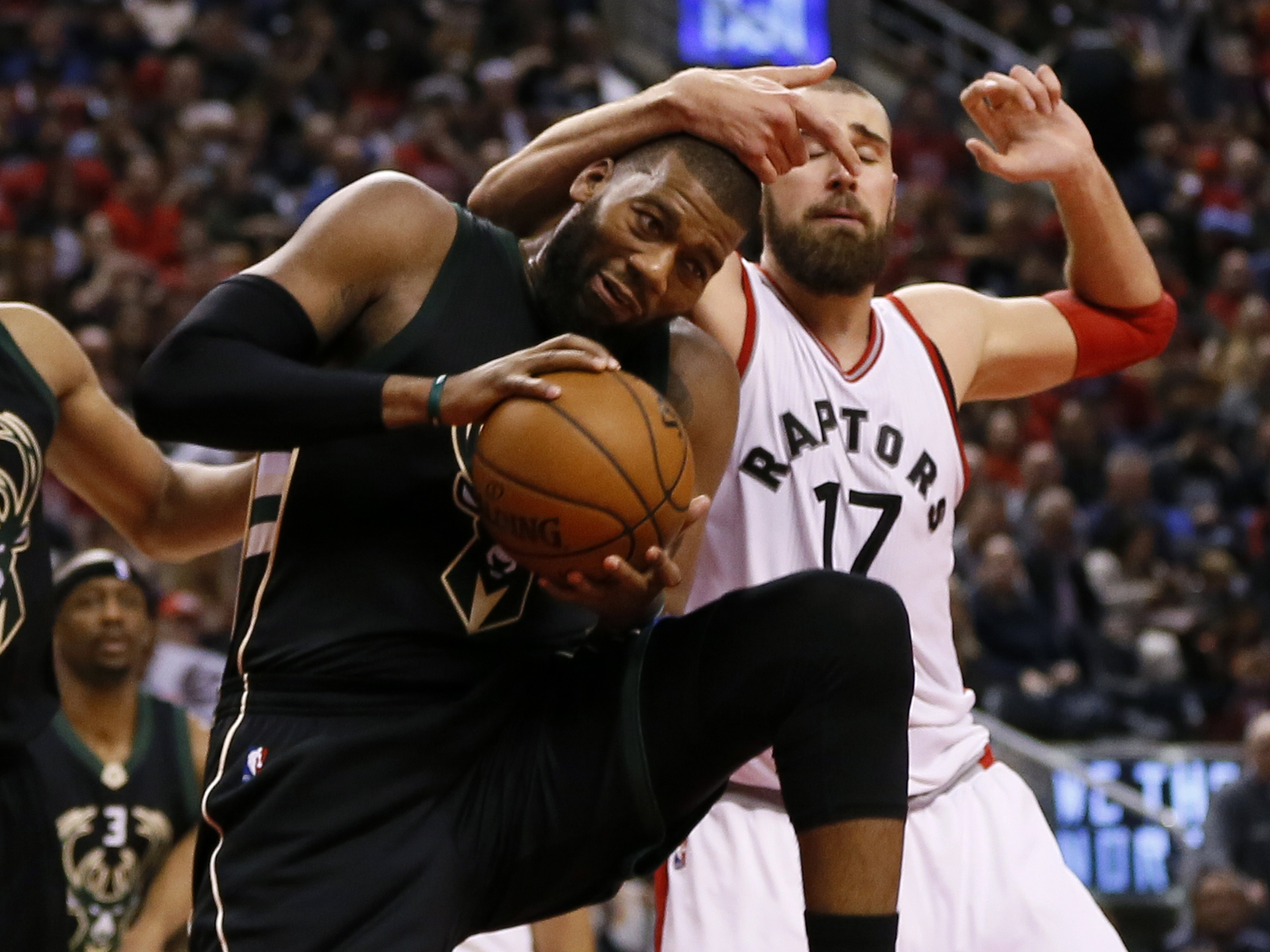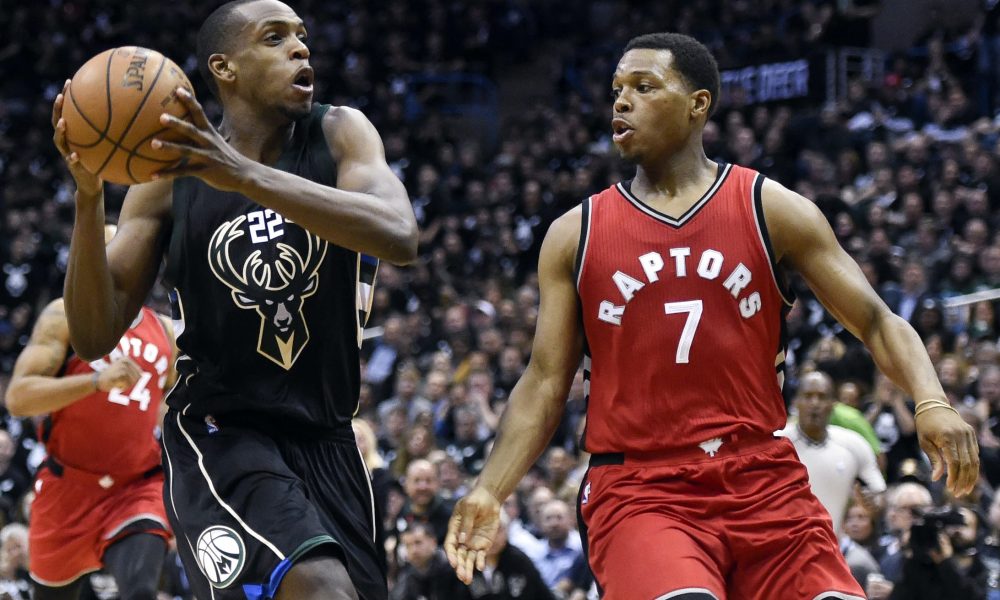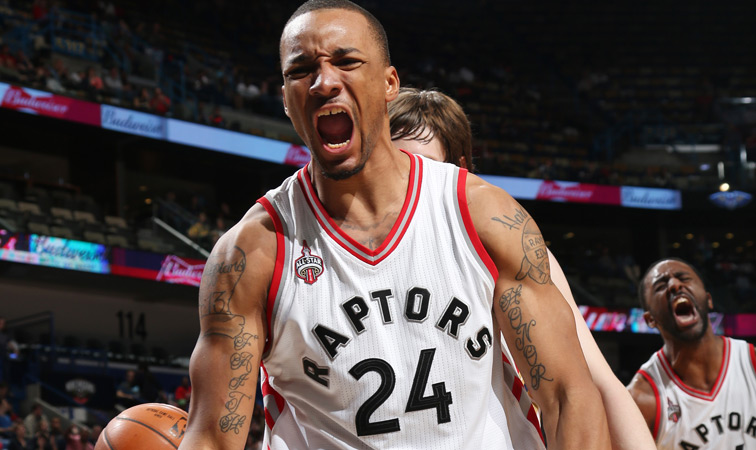Winners of two games in a row, the Toronto Raptors are keenly aware that the Milwaukee Bucks will have spent the two days between Games 5 and 6 looking for ways to improve. Like the Raptors themselves did after an embarrassing Game 3 loss, the Bucks likely engaged in some lively film sessions, and head coach Jason Kidd is surely on the hunt for ways of saving, and perhaps taking back control of, this series.
“We think about that after every game. Win, lose or draw we try and anticipate what they’re going to do. That’s part of the chess match at this time,” head coach Dwane Casey said Wednesday. “We think about the what ifs but you can’t spend a lot of time on the what ifs. You’ve got to work on basically what is hurting you too but we have to be ready for the what ifs.”
Tactically, the Bucks may not change a great deal. Their defense is what it is, their aggression who they are, and too big a divergence from their base approach seems unlikely. The options available in that regard may be unpalatable, anyway – as much as Toronto’s role players, particularly Norman Powell, have stepped up over the last two meetings, Milwaukee isn’t going to want to dare DeMar DeRozan and Kyle Lowry to beat them against less pressure. If they do opt to go that way, the Raptors, as one of the league’s best driving and isolation teams, are well-equipped to take advantage, even if length awaits in the form of help defense at the rim. If Milwaukee approaches things more or less the same, the Raptors have their formula for beating it, they just have to stick to it.
Offensively, there’s more the Bucks can do, using their base corner offense a little bit more to hunt off-ball mistmatches or have Greg Monroe go to work at the elbows, and they’ve talked up trying to get megastar Giannis Antetokounmpo the ball on the move more. The Raptors have helped themselves out in that last regard by making more shots, but they’ve still struggled to contain Milwaukee in transition. The Raptors are the postseason’s best defense against pick-and-roll ball-handlers by a long shot and third-best against isolation, but only the San Antonio Spurs are scoring more points per-possession after turnovers than the Bucks, a key point of emphasis for Toronto (thanks in part to the starting lineup change, the Raptors have started doing much, much better guarding after defensive rebounds, and Milwaukee ranks bottom-three in the playoffs both off of Raptor misses and Raptor makes on a per-possession basis).
How, specifically, Milwaukee might tweak their approach is something Cooper Smither is going to touch on with a film break down a little later. Beyond the tactical, the Bucks could also try to swing the series with a starting lineup change of their own, or tweaks to their rotation. Here are some of their options.
Start Greg Monroe
Monroe has come off of the bench for the entirety of the Bucks’ season, but they have 67 games of experience with him starting with a lot of these same pieces from last year. What’s more, the Bucks’ corner offense is their base offense, and Monroe is an important part of it, working as a distributor from the elbows or from the block. The transition to Monroe as a starter really wouldn’t be that big an upheaval, and the team’s starters with Monroe in place of Thon Maker played 86 minutes in the regular season (the team’s seventh-most used lineup) and were a plus-1.5 points per-100 possessions (They’ve played 20 minutes in this series to a -3.4 net rating, too).
There’s some sound logic to making this move, even if Maker hasn’t done anything to deserve to lose his spot. Similar to when the Raptors sent Jonas Valanciunas to the bench, it’s about maximizing the team over 48 minutes, and the move to Serge Ibaka at center opposite Maker has swung those groups back in Toronto’s favor. Maker’s floor-spacing isn’t valuable enough to off-set Toronto’s new ability to switch across positions, and Ibaka can pull Maker away from the rim more or punish extra space (that he’s shot a ton the last two games should not be surprising). Meanwhile, when the Bucks have turned to Monroe, he’s had success against Ibaka.
The issue for Milwaukee here is two-fold. For one, the Raptors would be aggressive in attacking Monroe in the pick-and-roll on consecutive possessions, something that worked well earlier in the series. Monroe’s improved as a defender but still isn’t a great fit for the way Milwaukee’s starters guard, and forcing him to trap and recover repeatedly should wear him down and open up some holes. The starters with Monroe have bled points defensively (with either Milwaukee point guard, actually) in this series. Second, if Monroe swings that trade-off in his favor, the Raptors have a ready-made solution in the form of Valanciunas. I have a piece on that particular matchup coming for Vice later today, but here’s a nugget:
Valanciunas is winning his minutes opposite Monroe – Monroe’s shooting percentage drops from 60 to 50 with Valanciunas opposite him, his rebounding percentage drops five percentage points, and his turnover rate increases. The Raptors have outscored the Bucks by 14 points in 65 minutes the two centers have gone head-to-head and been outscored by 18 in Monroe’s other 52 minutes, per NBA.com.
The Raptors won’t be able to respond with Valanciunas starting the first quarter, but they gave Ibaka a quick hook in the second half of Game 5 and wouldn’t have much trouble adjusting their rotation on the fly to line Valanciunas up with Monroe. This move is probably Milwaukee’s best bet at goosing their offense, but it’s probably not a big needle-mover overall.
Play Antetokounmpo at center
This is kind of Milwaukee’s nuclear option that we’ve talked about here a few times during the series. Antetokounmpo can play any position on the floor, really, and he’s large enough to capably play center on defense, especially when Valanciunas is on the bench (and even when he’s not, really, since the Raptors have been hesitant to post him up against long Bucks for fear of turnovers). In that position, he could act as a rim protector and a free safety help defender of sorts, technically checking Toronto’s worst shooter and roaming off of him, or checking a screener and adding extra length to Milwaukee’s traps. They could also just put Antetokounmpo and Khris Middleton on DeRozan and Ibaka and play those matchups in a more straight-up fashion with very good defenders, or throw them on Lowry and DeRozan and make Ibaka beat them.
It’s at the other end where this could really be deadly, though, and it would be almost impossible for the Raptors to play Valanciunas against this look. Antetokounmpo flanked by even more shooting and ball-handling could help give him space and push the tempo, and Toronto would have to risk helping off of more complete offensive players than Maker (Antetokounmpo is among the league’s very best roll men, statistically, and adding shooting around that almost always helps). The counter for the Raptors would be to ask Ibaka to guard Antetokounmpo and eschew help at the rim, or to get even more aggressive switching Antetokounmpo and Middleton matchups.
This would also serve to get one more defender on the floor in Matthew Dellavedova, or get an offensive punch with Michael Beasley. Hearing those names, the Raptors probably wouldn’t be all that worried – it’s a tough matchup look, but Milwaukee is so thin on effective two-way pieces that it’s hard to go to this option without opening something up for Toronto. Beasley would be another option to attack on defense, and the Bucks playing two point guards would make matchups a little more straight-forward for the Raptors while also opening up some smaller lineup options.
“There’s some things they can do differently and we’re prepared for that,” Casey offered. “They can do some things defensively and we’re prepared for that too. There’s not a lot new that we haven’t seen that they’ve done and it’s going to have to be something totally out of character for them to come out tomorrow night.”
The biggest challenge for Toronto here would be that there’s not a lot of familiarity. Quietly, they have prepared for Milwaukee to try this out. But they’re basing it on some assumptions, as the Bucks only played 126 minutes this year where Antetokounmpo was on the floor without one of Maker, Monroe, Spencer Hawes, John Henson, or Miles Plumlee, per NBAWowy.com, and 83 of those involved Jabari Parker. They don’t have to start with this look, of course, but if the Raptors defend well again, I could see Kidd hitting the last-resort button and seeing what this super-spread lineup can do.
Other rotation tweaks
The Bucks could opt to keep their starting lineup the same, and if I had to guess, that’s what I think they’ll do. That doesn’t mean they won’t tweak, though, or even use a combination of more Monroe earlier and Antetokounmpo at center. Maybe John Henson factors in. Outside of the decision at center, Kidd has to continue to evaluate how much he can play Beasley, Jason Terry, and Mirza Teletovic, and he absolutely has to avoid playing all three together again. Kidd’s rotation has basically been seven players and then throwing guys out to see who won’t be exposed, and Beasley’s the only eighth man with whom the Bucks have had any success. Expect Antetokounmpo to play well over 40 minutes again. The Bucks just don’t have enough bodies without him.
Whatever the moves, Casey is ready to adjust quickly and give struggling lineups or players a quick hook.
“You have to,” he said. “The most important thing about that is that players have to understand the moment. I probably wouldn’t have pulled out a quicker hook during the regular season, or make substitutions as quickly as we would now, just because you don’t have time to make up for it. Each game is so important. Each possession is so important…They understand and know what is needed on the floor and who is best equipped on our team to handle it.”
That the talk leading up to Thursday’s game is about what the Bucks can do, and that rotation options seem flimsy, is encouraging for the Raptors. They’re in control of the series and have found a rotation that matches up well to minimize Milwaukee’s strengths. Being deeper and more flexible helps, and so does an otherworldly spark from Norman Powell. Toronto’s in a better position to close out a series early than they felt on either occasion last year, and it’s the looming threat of Toronto regressing to their usual selves on offense, not a Milwaukee change, that poses the biggest Game 6 challenge.
“We gotta go do our job,” Lowry said. “We make adjustments on the fly. One thing about basketball, it’s a game of reaction. You gotta try to make someone react, and you gotta react to their reaction. At the end of the day, we gotta prepare our team for what we can control. We don’t know what they’re gonna do, or what they’re gonna do differently. We gotta go out there and control what we can control, and that’s playing hard, playing defense and making sure that we take good shots and get back on defense.”




